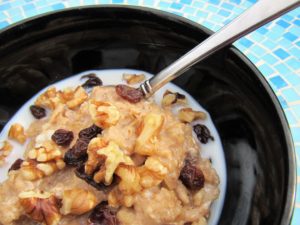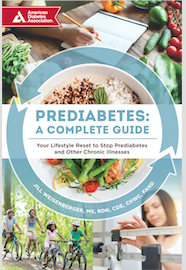
According to the CDC, 9.3% of the population has diabetes, BUT, 3X as many people have prediabetes. Essentially, 1 out of 3 individuals have prediabetes, but the sad part is that 90% of them don’t even know it! Today, we are shining light on this condition and what you can do to drastically reduce your odds of getting diabetes.
Sugar often takes the brunt of the blame when it comes to the onset of diabetes, but there are many lifestyle factors that all contribute to the development (and prevention) of diabetes. Staying on top of your health and getting proactive can help you stop it for good.
 Fellow Registered Dietitian, Jill Weisenberger, is a Certified Diabetes Educator, Health Coach and author of the newest American Diabetes Association book, Prediabetes: A Complete Guide. This book is “Your Lifestyle Reset to Stop Prediabetes and Other Chronic Illnesses.”
Fellow Registered Dietitian, Jill Weisenberger, is a Certified Diabetes Educator, Health Coach and author of the newest American Diabetes Association book, Prediabetes: A Complete Guide. This book is “Your Lifestyle Reset to Stop Prediabetes and Other Chronic Illnesses.”
An expert in all things diabetes, Jill makes the nutrition science understandable, practical and delicious. As a mom and wife, she knows the real-life struggles of feeding a family and making health a priority among the ins and outs of a busy life. Answering some of the most common questions about prediabetes, she is clearing up confusion about carbs, medications, symptoms, genetics and MORE in my interview with her.
Whether you have a family history of diabetes, have recently been told you have prediabetes or simply want to stay proactive managing your health, this article is for you!
What exactly is prediabetes and how is it different from diabetes?
Prediabetes and type 2 diabetes are basically the same problem at different stages of progression. They are both defined by blood glucose levels, but they are metabolic problems much broader than blood glucose.
If your blood glucose level is above normal but below the level of diabetes, you have prediabetes. Both prediabetes and type 2 diabetes are characterized by faulty insulin production and decreased insulin sensitivity. Basically, the cells of the body are resistant to the effects of insulin. And the pancreas cannot make enough insulin to tamp down the levels of glucose in the blood adequately. Previously, the pancreas was able to do that, but over time, the beta cells of the pancreas – the cells that make insulin – fail. Gradually, blood glucose levels rise to the prediabetes stage.
Without making changes, 37% of people with prediabetes will probably progress to full-blown diabetes within 4 years and most of them will have type 2 diabetes within a decade.
Beyond blood glucose levels, prediabetes (and type 2 diabetes) affects the liver, blood vessels, blood pressure, triglycerides and more. Prediabetes increases the risk for heart disease, stroke, fatty liver and some types of cancer. It’s a big myth that prediabetes and type 2 diabetes are blood sugar problems. They are metabolic problems that affect chronic inflammation and organ systems throughout the body in addition to causing elevated blood glucose levels.
What are symptoms of prediabetes?
Usually, there are none. And this is why it’s so important to discuss your risk with your healthcare provider. Even though about 84 million adults in the US have prediabetes, only about 9 or so million know it. These are the lucky ones because they are the ones who know to do something about it. And there are lots of things that can be done!
The diagnosis might bring a lot of negative emotions – maybe fear, guilt, denial or sadness. But the flipside is that you’ve caught the condition in time. Your greatest opportunity for a reversal is today! Prediabetes and type 2 diabetes are progressive, so every day that window of opportunity closes just a little bit.
Is it solely treated with lifestyle, diet/food, exercise or also with medication?
There are so many different lifestyle changes that can help you stop prediabetes and prevent type 2 diabetes. And I talk about them in quite a bit of detail in Prediabetes: A Complete Guide. There’s lots of good news here because this is a condition that can be hugely helped with lifestyle solutions. The subtitle of my book really shows this. It’s “Your Lifestyle Reset to Stop Prediabetes and Other Chronic Illnesses.”
Sometimes medications are also used. Healthcare providers might prescribe the drug metformin as an add-on to lifestyle changes. Metformin is a common diabetes medication and is more frequently being used in prediabetes as well because it makes the body more sensitive to insulin. In the big federally-funded Diabetes Prevention Program, metformin reduced the risk of developing type 2 diabetes by 31% in the 3-year study and by 17% in the 15 years since the beginning of the study.
Today, the American Diabetes Association recommends metformin for many people with prediabetes who are very obese, have a history of gestational diabetes, are under the age of 60 or who have an A1C level of 6% or higher. A1C is a measure of average blood sugar levels for about 3 months. By definition, an A1C in the range of 5.7% and 6.4% is indicative of prediabetes.
Even though metformin was very successful in preventing or delaying type 2 diabetes, lifestyle changes were much more effective. Lifestyle reduced the risk of the disease by 58% during the 3-year study and by 27% 15 years after starting the study.

If someone has been diagnosed with prediabetes, what are the top 3 practical things they can begin doing today?
Hmm, picking the top 3 is pretty hard because there are so many. Now isn’t that an empowering thought! I think a lot of people already know that losing a little bit of weight (if overweight) is very helpful. So I’ll pick 3 different ones – but not in any particular order.
1.Take a walk anytime, but especially after a meal.
A 20-minute walk after a meal will help lower your blood glucose levels. That’s because one of the problems with prediabetes and type 2 diabetes is insulin resistance. In other words, the cells of the muscles, liver, fat and other organs are stubborn and don’t respond properly to insulin. But the muscle cells don’t need insulin to take up glucose during exercise. So insulin resistant or not, exercise moves glucose out of the blood and into the muscle cells. By the way, that’s one of the reasons that strength training is a smart idea. If you can build more muscle, you have more place for the glucose to go.
2.Eat non-starchy vegetables with most meals.
Not only are they low in calories and carbohydrates, but they are loaded with health-boosting, disease-fighting nutrients and phytonutrients.
3.Upgrade your carb choices.
A lot of people want to avoid carbohydrates. I don’t want them to do that. So many of the very foods we know to help prevent disease contain carbohydrates. Other than pure vegetable fat, all of our plant foods contain carbohydrates: vegetables, nuts, beans, fruit, whole grains. These foods are the ones that contain fiber (no animal foods do) and an array of antioxidants and anti-inflammatory compounds. So choose your foods (carb-containing foods and others) based on wholesomeness. A bowl of oatmeal and fruit is a much better choice than a breakfast cookie. A piece of fruit outshines pretzels. All day long we make choices about what to eat. Imagine what a difference we could make if we chose wisely much more often.
What foods (or nutrients) are important in the prevention of diabetes?
In their 2018 Standards of Medical Care, the American Diabetes Association notes that higher intakes of nuts, berries, yogurt, coffee, and tea are associated with reduced risk of type 2 diabetes. Conversely, red meats and sugar-sweetened beverages are associated with an increased risk of type 2 diabetes.
Beyond that, we have evidence that oats and barley are good choices because of the fiber called beta-glucan, which helps to improve insulin sensitivity. Beans, peas and lentils are also associated with improvements in both short-term and long-term blood sugar levels. Using herbs and spices is a good idea because they have the same types of health-boosters found in fruits and vegetables. Plus, it looks like trading in saturated fats like butter and lard for unsaturated fats like olive oil and avocado helps the body become less insulin resistant.

What should people know about “sugar-free” or “low sugar” foods?
It’s important to read food labels carefully. These foods may or may not be wholesome. They may not even be low carb. Sugar-free cookies are still cookies and are never a health food. That being said, it doesn’t mean that you can’t enjoy a cookie. I just want you to realize what you’re eating.
Can you share a favorite recipe “tweak”?
I share several ways to “healthify” your favorite recipes in my book. In fact, I have 17 recipes as examples. But probably my favorite tweak is to add vegetables to the foods you’re already eating or preparing. Why not add mushrooms, onions and green beans to spaghetti meat sauce? Stuff sandwiches with spinach, bell peppers and cucumbers. Load up pasta salad or potato salad with tomatoes, carrots, broccoli and the like. You’ll get more nutrition, more disease fighters and more volume of food for fewer calories.
If a family member or relative has prediabetes, what are some tips to demonstrate support without stigma?
It’s probably a good idea to ask: How can I support you? What would you like for me to do? And then it’s a good idea to do whatever that is, if you can.
It’s not helpful to police what someone eats or to scold someone for not exercising. Instead, help him or her be successful by being a good role model, sharing the chores for meal prep and help your family member find time for good self-care.
Is ‘Keto’ a good option for those with prediabetes?
A ketogenic diet frequently leads to weight loss. But let’s not lose sight that we’re going after health. We’re not is a contest for weight loss. A ketogenic diet omits so many disease-fighting foods. I ask my clients and readers to focus on the process of getting healthier, to focus on forming habits and to put efforts into having a helpful mindset. Following any super restrictive diet is opposite to those things.

How do genetics and family history play a role in the prevalence of diabetes?
I’m glad you asked this because it doesn’t get enough attention. Some people have genes that predispose the beta-cells of the pancreas to break down. This increases the risk of both prediabetes and type 2 diabetes, especially when insulin resistance is also present. So often, people want to blame themselves. But we can’t do anything about our genes. We can accept the situation and look to lifestyle solutions (and medications as necessary).
What role does sleep, rest and leisure play in blood glucose control?
More than most people realize. Sleep is not a luxury. It’s a necessity, and sleep deprivation has been shown to lower insulin sensitivity even in healthy people. Inadequate sleep is associated with type 2 diabetes, obesity and heart disease. It’s smart to aim for 7-8 hours of sleep nightly.
You know, lifestyle changes are hard. They aren’t hard because of a character flaw, it’s just hard to change habits. And it’s much harder if you’re stressed or sleep deprived. So sleep, stress management, rest and recreation are important in multiple ways.
How does exercise affect blood glucose? Is there a difference between cardio vs strength training?
Every single time you exercise, you boost insulin sensitivity for 2 to 72 hours. Every single time! So you should feel accomplished for every single exercise session.
Both cardio exercise and strength training are good for us. They both improve insulin resistance. And the combination is even better than either alone.
When you exercise your muscles, they take glucose out of your blood. So all exercise counts. Not sure what to do? Just think of anything fun. Walk your dog. Swing a hula hoop. Go dancing. Take a tennis lesson. It’s okay to start slowly. You just have to get started. A 5-minute walk is more than no walk. Depending on your health, you may need to work with a personal trainer, walk with a buddy or seek permission or advice from your healthcare provider.

If someone was just diagnosed with prediabetes, how would you encourage and inspire them moving forward?
Prediabetes has lifestyle solutions. That’s pretty empowering. That means that you are in control. Your best opportunity to a reversal is today. And that is what Prediabetes: A Complete Guide is all about – what you can do today to make a difference.
Connect with Jill on Facebook, Instagram or Twitter. Grab a copy of her new book and take 1 step to stop prediabetes in it’s tracks!
DISCLOSURE: This post contains affiliate links. If you purchase a product through this link, your cost will be the same but Healthy Inspiration will receive a small commission to help with the operating costs of this blog. Thank you for your support!
